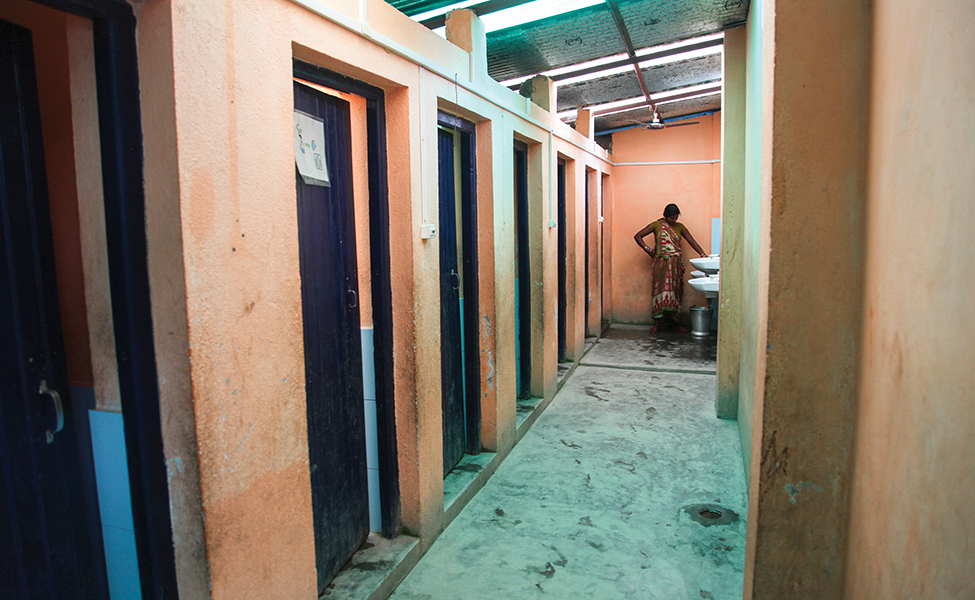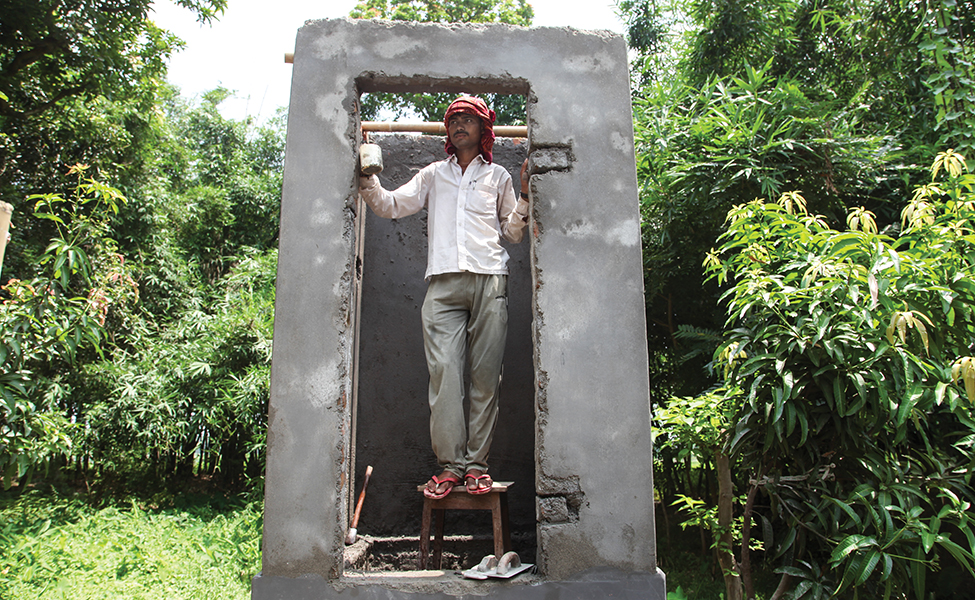In a Good Place
What’s the solution to India’s sanitation crisis? It’s not just more toilets.
"Don’t you know what a toilet is?”
The rusty auto-rickshaw flew over a pothole on the broken concrete road. Though I was hunched over in the backseat of the tiny, three-wheeled vehicle, my head slammed the ceiling. Eyes tearing, the sights around me blurred: Women in bold-colored saris working in the surrounding fields looked like smudges of blue and purple in an endless sea of bright, brilliant green. Dazed, I wondered whether I’d heard the translation correctly.
“I mean, don’t you know what a toilet is used for?” Laleshwor Kumar shouted at me over the roaring engine of the rickshaw. He looked taken aback.
With a fellowship from the Bloomberg School and the Pulitzer Center on Crisis Reporting, I’d come to Bihar, India, in June 2015 to report on open defecation. Bihar is a hotbed for this practice: In rural Supaul, the district where I stayed, only 30 percent of homes have toilets. Despite years of effort to curb it, the practice of relieving oneself outside has persisted in India. Recent studies showed that many Indians have a stated preference for open defecation.
Yet here I was with Laleshwor, a janitor at a local bank, on a quest to build a toilet. On this unbearably hot, sticky summer day, we rode into town from his rural home and I had asked why. What set him apart, I wondered, and made him want a toilet in his home when, according to the research I’d conducted from an air-conditioned American cubicle, so many Indians
did not?
For the next four weeks, I set out to answer the vexing public health question central to India’s current sanitation crisis: Why would an individual choose to not use a toilet even when one is available?
WHEN LOGIC FAILS
Over 600 million Indians defecate outside every day. Although India is not the only country where the practice of open defecation occurs, more than half of the people worldwide who relieve themselves in the open live in India. The practice has disastrous and well-recognized public health consequences. It results in premature death from diarrheal illness. It also leads to opportunistic violence against women and girls as they search for a place to relieve themselves, often alone at night. In 2012, a Bihar police official estimated that 400 rapes would have been avoided had women had a toilet in their homes. Furthermore, the economics of poor sanitation astound. In 2006, inadequate sanitation cost India an estimated 6.4 percent of its GDP ($53.8 billion USD) due to losses in education, productivity, time and tourism.
Tragically, poor sanitation contributes to physical and cognitive stunting of children. UN statistics estimate that 48 percent of Indian children under the age of 5 are stunted—this equates to more than 60 million children. The association between poor sanitation and stunting is complex and not completely understood. However, it is believed that repeated exposure to germs found in fecal matter during infancy causes permanent changes to the structure of the intestines, impeding absorption of essential nutrients and causing long-term inflammation throughout the body. This impairs growth of the body and brain.
Physical stunting, the most visible sign of these changes, seemed almost ubiquitous in rural Bihar. A baby in my host family, 16-month-old Abhinav, had big, watery eyes often made bolder by charcoal outline. He weighed just 7 kilos (15.4 pounds). He spent my first night in India in the hospital. Despite his mother’s diligent feeding, the doctor said he was malnourished. Weeks later, after he’d recovered from his acute illness, I found him quietly playing with his own feces as his mother scrubbed laundry nearby.
In recent years, the disastrous effects of poor sanitation have gained global recognition. Major philanthropic organizations such as the Bill and Melinda Gates Foundation now include water, sanitation and hygiene as key areas of work. In 2015, the UN made universal access to water and sanitation and an end to open defecation by 2030 one of its Sustainable Development Goals.

The Indian government has long acknowledged its sanitation woes but just recently launched a nationwide campaign against open defecation. Prime Minister Narendra Modi promised improvements in sanitation during his election campaign and has since launched Swachh Bharat, or Clean India Mission. Swachh Bharat will spend $22 billion to build 110 million toilets, with the goal of achieving universal sanitation and ending open defecation in India by 2019—well ahead of the UN’s target date.
I’d wondered why open defecation was gaining traction as an issue in public health now, when the Indian government had introduced rural sanitation programs to address open defecation six decades earlier, in 1954. My friends and family also wondered why this topic warranted a month of study in India. My sister-in-law said, “The solution is simple enough, right? Just build more toilets.”
Her argument seemed so logical, but this has not panned out in India. From 2005 to 2011, despite persistent toilet-building efforts, there was no change in the percent of households that used any kind of toilet or latrine. In some states, declining rates of open defecation have not kept up with population growth, leading to an increase in the overall number of people who defecate in the open.
Andrés Hueso, policy analyst for international NGO WaterAid, believes that earlier government sanitation efforts were lackluster, leading to poor outcomes. Underfunded and unable to meet the enormous need, programs provided poor services. “Households didn’t even get a decent toilet in most of the cases. Half-built toilets, toilets without paint, there were a lot of issues,” says Hueso.
More concerning to Hueso, however, is the supply-driven nature of sanitation programs. Historically, the government or an NGO constructed pit latrines (see sidebar) for households. Studies have shown, however, that many of these toilets—even those that are structurally intact—sit unused. Anecdotes about people who have access to toilets but don’t regularly use them prompted studies on why individuals don’t use toilets.
The influential 2014 Sanitation Quality, Use, Access, and Trends (SQUAT) report reinforced the strategy of generating demand for toilets. It found that “40 percent of households with a working latrine have at least one member who defecates in the open.” The study noted, “Many respondents told us that defecating in the open provides them an opportunity to take a morning walk, see their fields, and take in the fresh air. Many people regard open defecation as part of a wholesome, healthy, virtuous life.”
While conducting his PhD research on sanitation, sustainability, and policy in India, Hueso reported similar findings. “I think there is a real preference [for open defecation],” he says. “There are many reasons why and they vary for each individual. You can call it religion or culture or tradition or some kind of disgust of having to handle feces. So a lot of people prefer to go somewhere, drop it and leave instead of having it near the house and having to figure out what to do when [the toilet pit] fills up.”
Traditionally, the task of clearing human waste was performed by Dalits, or “untouchables.” Although the caste system has been illegal in India since the country’s independence in 1947, Hinduism’s social structure remains deeply ingrained in parts of the country, including in much of Bihar. The aversion to handling human waste or bringing Dalits into one’s home to perform these tasks is one proposed explanation for why some Indians continue to prefer open defecation.
The SQUAT report caught the attention of key philanthropists. Two years before the report, the Bill and Melinda Gates Foundation gave an $8.5 million, five-year grant to Population Services International (PSI). The project, which started as an effort to increase the supply of sanitation products and services, shifted focus after SQUAT was released, says Genevieve Kelly, PSI Water, Sanitation and Hygiene coordinator. “Given the findings in the report and emerging evidence [suggesting] that demand and use for toilets are intrinsically linked with ingrained cultural factors, Gates encouraged us to develop a strategy to address the social norm of open defecation in Bihar,” Kelly says. “Strengthening the supply … may not be enough.”
Many sanitation experts hope that behavior change programs, or “generating demand” for toilets, will help change the course of sanitation in India.
BEYOND HARDWARE
Both behavioral and hardware components must be addressed to improve sanitation, says Professor Tom Clasen, PhD, a sanitation expert at Emory’s Rollins School of Public Health. “It’s like when you started seeing seatbelts in cars. Some regulation required automobile companies to put seatbelts in cars, but it took years before people actually started using the seatbelts. If the program is all about putting seatbelts in cars, that’s what you’re going to get done. It doesn’t mean that people are going to use them.”
In India, he says, “you have generations, if not millennia, of people practicing open defecation. And now you’re giving them this hot, dark, stinky place that’s full of flies, and they’re supposed to go in there and defecate. You know, most of us would probably use open defecation over that alternative … and I’m pretty convinced if these folks had a bathroom to use like the one I have at home … they’d probably use it.”

Another important component of sanitation, Clasen argues, is fecal sludge management. Most toilets in Supaul are pit latrines, which must eventually be emptied. Faced with the eventuality of having to empty the pit or paying someone to empty it, people use them less. “It’s the same thing with people using septic systems in the States: They don’t flush as often. Or, if you have an unlimited data plan, you never think about how much you’re downloading. But if you have a limited data plan, you’ll think, ‘Maybe I don’t have to download that.’”
Furthermore, families with latrines are often not trained on how to safely empty them. While doing research, Clasen met people who rubbed kerosene on their bodies to minimize the smell of feces, then “they’ll jump in the pits and start shoveling it out. They use it for fertilizer in many cases. So, there’s a real question of whether [using this kind of toilet is] really minimizing exposure [to pathogens] at all.”
GETTING THE NUANCES RIGHT
I met Khailash Kumar (not related to Laleshwor) and his boss, a weather-beaten construction manager whose first name is Islam, on a toilet construction site. They were building a community toilet facility where the human waste from a series of pit latrines would collect in a tanker. As the feces decomposed, methane gas would be trapped, converted to electricity and used to power a water filtration system that would sell clean water back to the community members. Khailash, a young, single construction worker, laid bricks quietly but precisely. Islam was loud and lighthearted as he directed his workers around the compound.
With the scraping sounds of men shoveling concrete in the background, Khailash and Islam described how they use toilets selectively. Khailash usually relieves himself outside, but uses the pit latrine outside his family’s home when it is pouring rain. Islam uses his family toilet at home but relieves himself outside when he’s at work.
Neither Khailash nor Islam had ever heard of the SQUAT report. But when I told them about it, they disagreed with its findings. Islam does not believe that open defecation is associated with a healthy and virtuous rural life. “This is not the case.”
Khailash agrees, and with a mirthless laugh, says, “It’s too inconvenient to go outside. There are snakes, and we get yelled at when we use other people’s fields.”
Why, then. would Khailash continue to relieve himself outside when there is a toilet in his home? “If the men use the toilet,” he explains, “the pit will fill too quickly. Then where will the ladies go?” His family faces the challenges that Clasen has described; Khailash doesn’t appear to know what he’ll do when his pit fills, and he worries that his family will have to scrape up savings to pay someone to deal with it.

Islam only uses a toilet at home but not at work because, as a construction manager for small village projects, there are rarely toilets at the sites where he works. Only the big companies provide onsite toilets for workers. “You end up having to go out in the open. If you are working at someone’s home, they won’t even let you use their toilet,” he says, shaking his head at the irony: Even when working on a toilet-building project, he and his construction team usually have nowhere to relieve themselves except in the fields near the site.
Sunita Kumari (unrelated) cleans the women’s side of a community toilet block in Nimua, a village a few miles away from the one Khailash and Islam are constructing. As a woman and a Dalit, Sunita belongs to two of the most marginalized social groups in her society. When she tells me she only uses the toilet when she’s at work but not at home, her voice is barely above a whisper. She casts her eyes down at her work-worn hands and explains she does not have a toilet at home. She walks 40 minutes to work each day, so she often has no choice but to relieve herself outside.
Many others—teachers in schools, priests in temples, unemployed men in their homes—echoed the sentiments of Khailash, Islam and Sunita. They believe that poor sanitation is a huge issue in their communities and that most people would use toilets if they were convenient and their pits did not have to be emptied regularly. People in Nimua talked eagerly about their toilet facility. They felt pride that—with more than 750 users daily—their community had become much cleaner.
The mass construction of toilets has not ended open defecation in India. Behavior change efforts are important, yet they will not solve the problem if those who want toilets cannot afford to build them. Perhaps the government and NGOs need to consult more people like Khailash, Islam and Sunita, to customize toilet construction projects to the individual and community. However, the challenges of affordability and scalability of customized toilets will remain. The path forward is far from clear.
Still, Khailash looks hopeful when he discusses his family’s plans to eventually replace their temporary toilet with a more private, permanent one. “We’ll all be able to use it then.”
